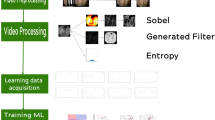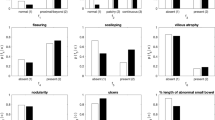Abstract
Celiac disease is a genetically determined disorder of the small intestine, occurring due to an immune response to ingested gluten-containing food. The resulting damage to the small intestinal mucosa hampers nutrient absorption, and is characterized by diarrhea, abdominal pain, and a variety of extra-intestinal manifestations. Invasive and costly methods such as endoscopic biopsy are currently used to diagnose celiac disease. Detection of the disease by histopathologic analysis of biopsies can be challenging due to suboptimal sampling. Video capsule images were obtained from celiac patients and controls for comparison and classification. This study exploits the use of DAISY descriptors to project two-dimensional images onto one-dimensional vectors. Shannon entropy is then used to extract features, after which a particle swarm optimization algorithm coupled with normalization is employed to select the 30 best features for classification. Statistical measures of this paradigm were tabulated. The accuracy, positive predictive value, sensitivity and specificity obtained in distinguishing celiac versus control video capsule images were 89.82%, 89.17%, 94.35% and 83.20% respectively, using the 10-fold cross-validation technique. When employing manual methods rather than the automated means described in this study, technical limitations and inconclusive results may hamper diagnosis. Our findings suggest that the computer-aided detection system presented herein can render diagnostic information, and thus may provide clinicians with an important tool to validate a diagnosis of celiac disease.







Similar content being viewed by others
References
Parzanese, I., Qehajaj, D., Patrinicola, F., Aralica, M., Chiriva-Internati, M., Stifter, S. et al., Celiac disease: From pathophysiology to treatment. World Journal of Gastrointestinal Pathophysiology 8(2):27–38, 2017.
Silvester, J., Duerksen, D., Celiac disease. Canadian Medical Association Journal, vol. 185, no.1, 2013.
Rubio-Tapia, A., Lidvigsson, J. F., Branter, T. L., Murray, J. A., and Everhart, J. E., The prevalence of celiac disease in the United States. American Journal of Gastroenterology 107(10):1538–1544, 2012.
World Gastroenterology Organisation, Celiac disease. WGO Global Guidelines:1–29, 2016.
Oberhuber, G., Granditsch, G., and Vogelsang, H., The histopathology of coeliac disease: time for a standardized report scheme for pathologists. European Journal of Gastroenterology & Hepatology 11(10):1185–1194, 1999.
Koh, J. E. W., Hagiwara, Y., Oh, S. L., Tan, J. H., Ciaccio, E. J., Green, P. H., Lewis, S. K., and Acharya, U. R., Automated diagnosis of celiac disease using DWT and nonlinear features with video capsule endoscopy images. Future Generation Computer Systems 90:86–93, 2019.
Green, P. H. R., The role of endoscopy in the diagnosis of celiac disease. Gasteroenterology & Hepatology 10(8):522–524, 2014.
Ciaccio, E. J., Lewis, S. K., Bhagat, G., and Green, P. H., Coeliac disease and the video capsule: what have we learned till now. Annals of Translational Medicine 5(9):197–197, 2017.
Vecsei, A., Fuhrmann, T., Liedlgruber, M., Brunauer, L., Payer, H., and Uhl, A., Automated classification of duodenal imagery in celiac disease using evolved Fourier feature vectors. Computer Methods and Programs in Biomedicine 95:68–78, 2009.
Ciaccio, E. J., Tennyson, C. A., Bhagat, G., Lewis, S. K., and Green, P. H. R., Classification of videocapsule endoscopy image patterns: comparative analysis between patients with celiac disease and normal individuals. Biomedical Engineering 9(44):1–12, 2010.
Ciaccio, E. J., Tennyson, C. A., Lewis, S. K., Krishnareddy, S., Bhagat, G., and Green, P. H., Distinguishing patients with celiac disease by quantitative analysis of video- capsule endoscopy images. Computer Methods and Programs in Biomedicine 100(1):39–48, 2010.
Ciaccio, E. J., Tennyson, C. A., Bhagat, G., Lewis, S. K., and Green, P. H. R., Robustspectral analysis of videocapsule images acquired from celiac disease patients. Biomedical Engineering 10(78):1–14, 2011.
Gadermayr, M., Wimmer, G., Uhl, A., Kogler, H., Vecsei, A., and Merhof, D., Fully-automated CNN-based Computer Aided Celiac Disease Diagnosis. Image Analysis and Processing 6978:467–478, 2011.
Ciaccio, E. J., Tennyson, C. A., Bhagat, G., Lewis, S. K., and Green, P. H. R., Use of basis images for detection and classification of celiac disease. Biomedical Materials Engineering 24:1913–1923, 2014.
Zhou, T., Han, G., Li, B. N., Lin, Z., Ciaccio, E. J., Green, P. H., and Qin, J., Quantitative analysis of patients with celiac disease by video capsule endoscopy: a deep learning method. Computers in Biology and Medicine 85:1–6, 2017.
Ciaccio, E. J., Bhagat, G., Lewis, S. K., and Green, P. H., Extraction and processing of videocapsule data to detect and measure the presence of villous atrophy in celiac disease patients. Computers in Biology and Medicine 78:97–106, 2016.
Ciaccio, E. J., Bhagat, G., Lewis, S. K., and Green, P. H., Recommendations to quantify villous atrophy in video capsule endoscopy images of celiac disease patients. World Journal of Gastrointestinal Endoscopy 8(18):653–662, 2016.
Winder, S., Hua, G., Brown, M., Picking the best DAISY image descriptors, Image(Rochester, N.Y.), 2009.
Tola, E., Lepetit, V., DAISY: An Efficient Dense Descriptor Applied to Wide-Baseline Stereo, IEEE Intelligence on Pattern Analysis and Machine Intelligence, vol.32, no.5, 2010.
Shannon, C. E., A Mathematical Theory of Communication. The Bell System Technical Journal 27(3):379–423, 1948.
Couceiro, M., Ghamisi, P., Particle Swarm Optimization, Fractional Order Darwinian Particle Swarm Optimization: Applications and Evaluation of an Evolutionary Algorithm, pp.1-10, 2016.
Lowe, D., Distinctive image Features from Scale-Invariant Keypoints, International Journal of Computer Vision, pp.1-28, 2004.
Acharya, U. R., Faust, O., Kadri, N. A., Siru, J. S., and Yu, W., Automated identification of normal and diabetes heart rate signals using nonlinear measures. Computers in Biology and Medicine 43(10):1523–1529, 2013.
Guyon, I., and Elisseeff, A., A, An Introduction to Variable and Feature Selection. Journal of Machine Learning 7(8):1157–1182, 2003.
Hua, W. T., and Dougherty, E., Performance of feature-selection methods in the classification of high-dimension data. Pattern Recognition 42:409–424, 2009.
Kohavi, R., and John, G., Wrappers for Feature Subset Selection. Artificial Intelligence 97:1–2, 1997.
Kennedy, J., Eberhart, R., Particle swarm optimization, in: Proceedings of the IEEE International Conference on Neural Networks, Perth, WA, Australia, 1995.
Girdhar, A., Swarm Intelligence and Flocking Behaviour, International Journal of Computer Applications, pp. 975-8887, 2015.
Cortes, C., and Vapnik, V., Support-Vector Networks. Machine Learning 20:273–297, 1995.
Duda, R. O., Hart, P. E., Stork, D. G., Pattern classification, second edition, John Wiley and Sons, New York, 2001.
Tola, E., Lepetit, V., Fua, P., A fast local descriptor for dense matching, Conference on Computer Vision and Pattern Recognition, Alaska, USA, 2008.
Lee, J. G., Jun, S., Cho, Y. W., Lee, H., Kim, G. B., Seo, J. B., and Kim, N., Deep learning in medical imaging: General overview. Korean Journal of Radiology 18(4):570–584, 2017.
Faust, O., Hagiwara, Y., Tan, J. H., Oh, S. L., and Acharya, U. R., Deeplearningforhealth- care applications based on physiological signals: A review. Computer Methods and Programs in Biomedicine 161:1–13, 2018.
Lecun, Y., Bengio, Y., and Hinton, G., Deep Learning. Nature 521(7553):436–444, 2015.
Author information
Authors and Affiliations
Corresponding author
Additional information
Publisher’s Note
Springer Nature remains neutral with regard to jurisdictional claims in published maps and institutional affiliations.
This article is part of the Topical Collection on Image & Signal Processing
Rights and permissions
About this article
Cite this article
Vicnesh, J., Wei, J.K.E., Ciaccio, E.J. et al. Automated diagnosis of celiac disease by video capsule endoscopy using DAISY Descriptors. J Med Syst 43, 157 (2019). https://doi.org/10.1007/s10916-019-1285-6
Received:
Accepted:
Published:
DOI: https://doi.org/10.1007/s10916-019-1285-6




